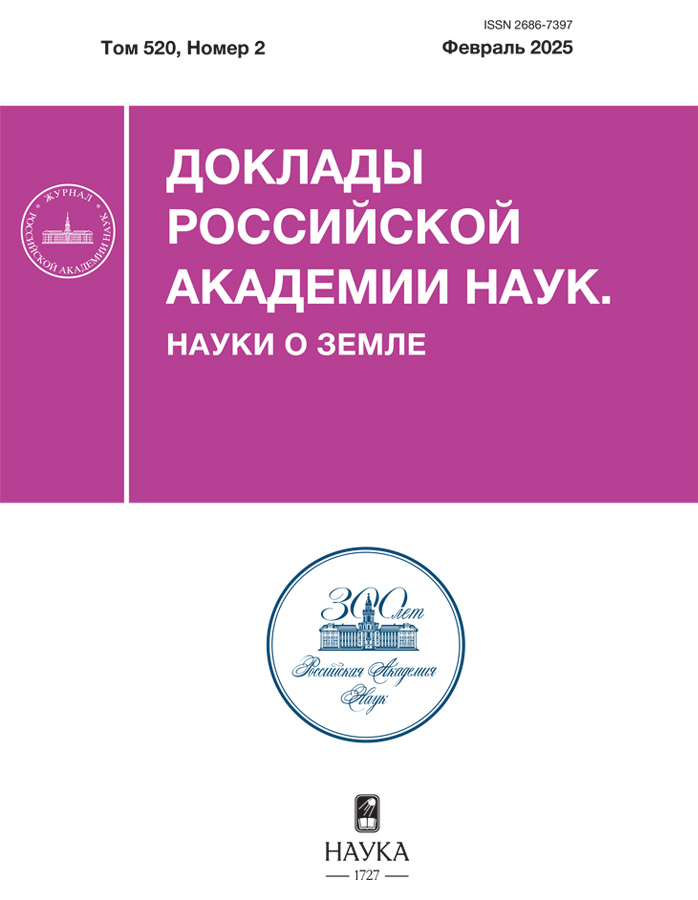Районирование лесных ландшафтов России для оптимизации регионального моделирования потоков парниковых газов
- Авторы: Харитонова Т.И.1,2, Криницкий М.А.1, Резвов В.Ю.1, Максаков А.И.1, Ольчев А.В.1,2, Гулев С.К.1
-
Учреждения:
- Институт океанологии им. П.П. Ширшова Российской Академии наук
- Московский государственный университет им. М.В. Ломоносова
- Выпуск: Том 520, № 2 (2025)
- Страницы: 333-339
- Раздел: ГЕОГРАФИЯ
- Статья получена: 19.06.2025
- Статья одобрена: 19.06.2025
- Статья опубликована: 04.09.2025
- URL: https://ruspoj.com/2686-7397/article/view/685370
- DOI: https://doi.org/10.31857/S2686739725020186
- EDN: https://elibrary.ru/GCMBLX
- ID: 685370
Цитировать
Полный текст
Аннотация
Проведено районирование лесной территории России для задач пространственной экстраполяции потоков парниковых газов в региональном и национальном масштабе. Методом простой линейной итеративной кластеризации по 12 переменным проведено деление исследуемой территории РФ на 78 экорегионов. Для районирования использованы пространственные данные о климатических характеристиках, рельефе, почвенном покрове и растительности из открытых источников, приведённые к сетке 0.0025˚×0.0025˚. Результаты кластеризации сопоставлены с экспертными схемами геоботанического и физико-географического районирования территории РФ. Выделенные экорегионы могут служить основанием для размещения новых мониторинговых площадок для наблюдений за потоками парниковых газов в лесных экосистемах.
Полный текст
Об авторах
Т. И. Харитонова
Институт океанологии им. П.П. Ширшова Российской Академии наук; Московский государственный университет им. М.В. Ломоносова
Автор, ответственный за переписку.
Email: kharito@geogr.msu.ru
Россия, Москва; Москва
М. А. Криницкий
Институт океанологии им. П.П. Ширшова Российской Академии наук
Email: kharito@geogr.msu.ru
Россия, Москва
В. Ю. Резвов
Институт океанологии им. П.П. Ширшова Российской Академии наук
Email: kharito@geogr.msu.ru
Россия, Москва
А. И. Максаков
Институт океанологии им. П.П. Ширшова Российской Академии наук
Email: kharito@geogr.msu.ru
Россия, Москва
А. В. Ольчев
Институт океанологии им. П.П. Ширшова Российской Академии наук; Московский государственный университет им. М.В. Ломоносова
Email: kharito@geogr.msu.ru
Россия, Москва; Москва
С. К. Гулев
Институт океанологии им. П.П. Ширшова Российской Академии наук
Email: kharito@geogr.msu.ru
член-корреспондент РАН
Россия, МоскваСписок литературы
- Upton S., Reichstein M., Gans F., Peters W., Kraft B., Bastos A. Constraining biospheric carbon dioxide fluxes by combined top-down and bottom-up approaches // Atmos. Chem. Phys. 2024. № 24. P. 2555–2582.
- Xiao J., Chevallier F., Gomez C., Guanter L., Hicke J.A., Huete A.R., Ichii K., Ni W., Pang Y., Rahman A.F., Sun G. Remote sensing of the terrestrial carbon cycle: A review of advances over 50 years // Remote Sensing of Environment. 2019. № 233. P. 111383.
- Pastorello G., Trotta C., Canfora E. et al. The FLUXNET2015 dataset and the ONEFlux processing pipeline for eddy covariance data // Sci Data. 2020. V. 7(225).
- Jung M., Reichstein M., Bondeau A. Towards global empirical upscaling of FLUXNET eddy covariance observations: validation of a model tree ensemble approach using a biosphere model // Biogeosciences. 2009. V. 6(10). P. 2001–2013.
- Hersbach H., Bell B., Berrisford P. et al. The ERA5 global reanalysis // Quarterly Journal of the Royal Meteorological Society. 2020. V. 146(730). P. 1999–2049.
- Fick S.E., Hijmans R.J. WorldClim 2: new 1 km spatial resolution climate surfaces for global land areas // International Journal of Climatology. 2017. V. 37(12). P. 4302–4315.
- Wikle C.K. Spatio-temporal methods in climatology // Encyclopedia of Life Support Systems (EOLSS). 2002.
- Yamazaki D., Ikeshima D., Tawatari R. et al. A high accuracy map of global terrain elevations // Geophysical Research Letters. 2017. V. 44(11). P. 5844–5853.
- Achanta R., Shaji A., Smith K. et al. SLIC superpixels compared to state-of-the-art superpixel methods //IEEE transactions on pattern analysis and machine intelligence. 2012. V. 34(11). P. 2274–2282.
- Golikov V., Krinitskiy M., Borisov D. Visual clustering of ocean sediment grains using a combination of unsupervised machine learning methods / Proceeding of the 6th International Workshop on Deep Learning in Computational Physics (DLCP-2022). Dubna, Russia. 2022. 429 p.
- Огуреева Г.Н., Леонова Н.Б., Булдакова Е.В. и др. Биомы России. Карта в серии карт природы для высшей школы. Масштаб 1:7500000. Издание 2-е, переработанное и дополненное. М.: Всемирный фонд дикой природы (WWF), 2018.
- Карта физико-географического районирования СССР. Гвоздецкий Н.А., Самойлова Г.С. (ред.). Масштаб 1:8000000. М.: ГУГК, 1986.
- Hargrove W.W., Hoffman F.M. Potential of multivariate quantitative methods for delineation and visualization of ecoregions // Environmental management. 2004. V. 34. P. S39–S60.
- Mackey B.G., Berry S.L., Brown T. Reconciling approaches to biogeographical regionalization: a systematic and generic framework examined with a case study of the Australian continent // Journal of Biogeography. 2007. V. 35. No. 2. P. 213–229.
- Ольчев А.В., Гулев С.К. Карбоновые полигоны Российской Федерации: цели, задачи, перспективы // Изменения климата: причины, риски, последствия, проблемы адаптации и регулирования / Под ред. академика РАН И.И. Мохова, члена-корреспондента РАН А.А. Макоско, к.ф.-м.н. А.В. Чернокульского. М.: РАН, 2024. С. 343–355.
Дополнительные файлы












